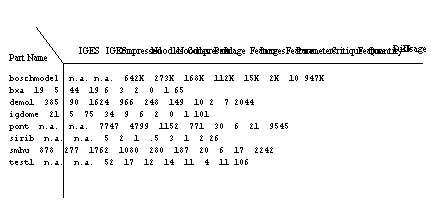6.6 COMPLEXITY: STORAGE AND PROCESSING REQUIREMENTS
6.6.2 COMPLEXITY MEASURES OF THE DFM SYSTEM
The complexity of the DFM system is asserted to be correlated to the storage and access requirements. The storage and access requirements of the DFM system for larger-scale projects are in turn asserted to correlated to the file size of the representations. Table 13 compares file sizes of part representations within the DFM system. Compression of files can make immediate gains in reducing storage requirements. Table 14 lists the average storage requirements.
Table 14 compares the compression statistics. Needless to say, there are too few data points to accurately quantify the gains made by compression, although a first-order characterization can be expressed. Noodles models can be compressed to half their original sizes. IGES files can be greatly reduced to up to a fourth their sizes. IGES file data is highly position dependant; there is much "white space", or rather spacing characters, that is used for buffering between data elements and can be substantially remove during compression.
Table 13 DFM File Sizes

Table 14 Compression Statistics
Name N Mean St.Dev Min Max
IGES 4 3.9 0.5 3.2 4.3
Noodles 8 2.2 0.5 1.6 3.1
Ascii Text 30 1.8 0.3 1.3 2.7
Table 15 assesses the order of magnitude for a some products. Generally, for a production ready DFM system, general disk usage could be estimated to average on the order of 10 megabytes per part. This is without data compression of the Noodles model and includes the ancillary representations for images, feature parameters, and critiques. Given that an automobile, as a whole, requires an order of magnitude in the tens of thousands of parts, or 104, to represent an entire automobile assembly would require 107 bytes per part * 104 parts = 1011 bytes or 100 gigabytes for each part.
Table 15 Part Order of Magnitude
Product Number of Parts
cordless drill 50
alarm clock, relay contactor , pc printer 102
machine tool 103
automobile 104
airplane 106 (half of which are fasteners)
Primary memory has ventured into the megabyte domain in recent years and is no longer measured in the 64K increments of the dawn of computers. Consideration of two or three parts at the time would require about 30 Megabytes of main memory. This is feasible under current technology. Representation of an entire automobile is not feasible.
Secondary storage of an entire part of the order of magnitude of 10 Gigabytes is possible on technologies such as compact disk write-once, read-many (WORM) and rewritable disk, or read-only disk. Optical disks offer access times of from 95 to 320 ms and storage of about 600 Megabytes [Powers 92]. Jukebox configurations offer hundreds of gigabytes of storage capacity. Secondary storage is not an issue except in terms of cost. Generally, a jukebox will cost between $69,000 and $200,000 for 16 Gbyte to 93 Gbyte capacities [Digital Review 91]. The archival of a complete automobile may be possible within a single jukebox.
Of real issue is access time. Recent advances indicate transfer rates of 1 Megabyte per second from 1 Gbyte optical drives [Brownstein 92]. To retrieve three 10 Megabyte models for analysis would require half a minute. Retrieval of a full assembly of perhaps 20 parts would require 200 Megabytes of main memory and more than three minutes retrieval time. Although the memory requirements are extensive, it is the access time which may be unacceptable to the user. Access time to simply retrieve a single document or set of documents is acceptable, however. The access to a fully detailed assembly would probably be required for computational purposes and not for user presentation.
The user would find acceptable a wait of several minutes to several hours for the running of a computational analysis. The DDPF feature extraction method takes about one to two minutes for an industrial part. PIMES Feature evaluation takes under five seconds. More rigorous analysis, such as that of finite element, may take from several minutes to several hours. The user usually finds a degree of patience in these situations. However, retrieval of a document or form is aggravating if delayed for a few seconds. With documents usually falling under a megabyte, a one second access time is appropriate.